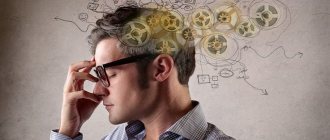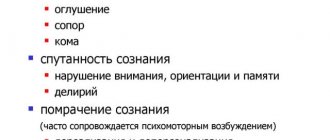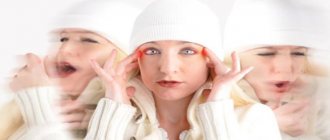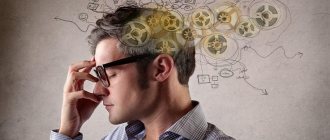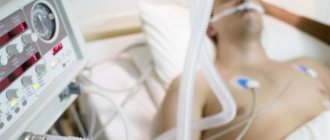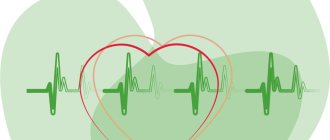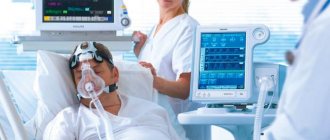The state of stupefaction is a pathological state of the psyche, the symptoms of which include increased emotional sensitivity to all stimuli from the outside world and a simultaneous dulling of higher nervous activity. This phenomenon also occurs under the name “stunned consciousness syndrome.”
Types of disease
There are several stages of this disease:
- Nullification;
- Doubt;
- Sopor;
- Coma.
Numbulation is a mild form of stunned syndrome. This condition implies an unstable state of consciousness. The state of health of a person suffering from numbing is similar to a state of mild intoxication, when the world around him seems to be in a fog, all mental reactions are slow, and the patient’s attention is scattered.
Doubtfulness is a deep stage of the state of stupor and is characterized by minimal physical activity of the patient, absence of facial expressions and any complaints about one’s well-being. A person suffering from somnolence is half asleep, has difficulty perceiving reality and expresses a response only when exposed to very strong stimuli.
Reference! Stupor and coma are severe stages of this syndrome, and are characterized by an almost unconscious state of the patient and, in some cases, leading to death. However, it is important to note that the disease progresses to such stages relatively less frequently.
Types of non-productive disorders of consciousness
Disturbances of consciousness can be productive or unproductive. With the latter, the activity of consciousness is reduced and there are no productive psychopathological symptoms, that is, deceptions of perception and delusions. There are three forms:
- stun
- sopor
- coma
Stun
When a person is deafened, the threshold for perception of external factors and internal impressions increases. Mental activity becomes poor, gradually fading away to an increasing extent. When stunned, only a very intense factor can attract a person's attention. A person does not answer questions immediately, and may not understand complex sentences. He usually answers after a long silence and in short phrases.
When a person is stunned, he is poorly oriented where he is and what places are located relative to the point where he is at the moment. There may be no orientation at all. A person is prone to indifference, akinesia, spontaneity and drowsiness. The voice is quiet, there is no modulation in it, there are no gestures, minimal facial expressions. Perseverations are recorded. The person does not remember that he was in a state of stun for some time. There are no fears.
Nullification
This condition is a mild degree of stunning. At the same time, the person seems uncollected or a little drunk. The meaning of speech (if addressed) is understood after some time. The answers may not correspond to the question, and the actions may also seem incorrect. There may be euphoria and fussiness. At times, for some moments, the person returns to normal consciousness.
An example of nullification: a person was injured in an accident, but does not understand this, and begins to actively remove doctors and try to help his loved ones who also suffered in this situation.
Somnolence
This condition is a form of unconsciousness. The person is very sleepy. If you don’t talk to him or make physical contact, he immediately falls soundly asleep. If you shake him and talk to him, he wakes up. But then he falls asleep again. Somnolence is noted upon recovery from an epileptic coma after seizures. After a seizure, you should not try to wake the person. This is not only difficult, but also dangerous, because it can cause an outbreak of aggression in the patient.
Stun
In its manifestations, stunning is similar to psychoorganic syndrome, but these are not synonyms. Main features:
- memory weakness
- impaired judgment
- aspontaneity
- torpidity
Stunning occurs in patients who are emerging from a coma. After stunning, a coma or a state of stupor can be recorded, which will be discussed in detail below.
Causes of stunning:
- swelling and swelling of brain tissue
- lack of oxygen reaching the brain
- acidosis due to intoxication, skull injury, etc.
Sopor
In this state, a person has only minimal signs of mental activity. If you call his name loudly, the person may turn around. If a person feels pain, he groans or tries to avoid the source of pain. Neurological disorders are also characteristic:
- decreased skin reflexes
- minimizing periosteal reflexes
- weakened tendon reflexes
- decreased muscle tone
Conjunctival and pupillary reflexes, as well as sensitivity, remain normal.
Coma
This condition is characterized by complete depression of mental activity. Main features:
- pelvic disorders
- pathological reflexes
- mydriasis with lack of pupillary response to light
- bulbar disorders
- lack of reflexes
- muscle atony
Transcendent coma is brain death, in which the functioning of internal organs is supported with the help of special devices. The condition is also known as supernumerary coma.
Causes
The causes of stunned consciousness syndrome in humans are circulatory disorders or serious damage to brain structures.
Most often, deafness occurs precisely as a result of severe injuries to the skull. At the same time, symptoms can appear either immediately after the injury or after some time.
Acute cerebrovascular accidents are also a common cause of this syndrome. For example, ischemic stroke, cerebral hemorrhage, transient cerebrovascular accidents, etc.
Among the causes of stunned consciousness, severe bacterial and viral diseases, such as inflammation of the membranes of the brain or liver tissue, can also be identified.
The most common causes also include endogenous or exogenous intoxication of the body, due to an overdose of drugs, sleeping pills, or poisoning with products that contain ethanol.
Attention! According to medical practice, the cause of blackouts in a milder form is alcohol or drug intoxication.
Productive disorders
Non-productive disorders are discussed above. And the productive ones include:
- amentia
- twilight stupefaction
- oneiroid
- delirium
Delirium
The main signs (symptoms) of this type of consciousness disorder:
- Perceptual disturbances of various forms:
- sensory synthesis disorders
- hallucinations
- illusions
- tactile illusions of perception
- impairment of remembering what is happening, etc.
As for illusions, patients with delirium mainly experience visual illusions. There may also be hallucinations of the following kind:
- cobweb or threads
- wires
- macro- and micropsychic
- polyopic
- cinematic
- palingnostically
- demonomaniacal
- zoological
- scene-like
With delirium, the patient's thinking is characterized by fragmentation, and false recognitions may occur. The patient remembers this period poorly after regaining consciousness. The orientation on the spot is constantly changing and does not correspond to reality. The same applies to orientation in the current situation, the people around you and time. But a person is almost always aware of who he is.
Another feature of delirium is affective lability. A person can quickly change from curiosity to fear to indignation and vice versa. Mostly emotions are negative. A person in this state has a great desire to move, do and say something. A person can defend himself from his hallucinations, attack imaginary and real people, run away, etc. During the day, the symptoms of delirium appear less.
Oneiroid
This is a clouding of consciousness, which is characterized by fantasies, delusions and dreams. Basically, polymorphic psychopathological symptoms are observed. The person experiences pseudohallucinations and scene-like hallucinations. In most cases, catatonic disorders and affective disorders are observed. Fantastic delusional ideas are typical.
A person’s experiences are subject to one direction, one theme. Painful experiences have a romantic-fantasy theme. When a person regains consciousness, he tells doctors and loved ones that he was on other planets, traveled through time, etc. Many people like what they saw so much that they regret that they returned to a normal, healthy state.
For oneiroids, disturbances in orientation in one’s personality are typical. A person considers himself to be another creature, often not a human. That is, the patient himself takes part in his fantasies as an active person, and not as an outside observer. The somatopsychic sphere is involved. A person may believe that his body has become gaseous or consisting of some fantastic matter. The patient is not oriented completely or to a greater extent in the surrounding world. When the peak of the state in question comes, the person is completely detached from what is happening around him. He completely lives the moment in an imaginary world, where he does not see or feel anything that surrounds him in reality.
It is almost impossible or completely impossible to contact a person in a oneiroid state. It is impossible to understand his hallucinations and illusions by the way a person behaves. When the patient returns to consciousness, he does not remember how he behaved, what happened around him, but he remembers his illusions well.
Oneiric clouding of consciousness is observed during attacks of schizophrenia of the fur-like or periodic type, during intoxication psychoses, exogenous-organic and epileptic psychoses. Oneiroid in many cases occurs before delirium, therefore it is very difficult to distinguish between these two states in psychosis.
Twilight stupefaction
The beginning of the condition is always abrupt, as is the ending. The circle of thoughts and motives narrows significantly. A person comes into a state of extreme excitement, and therefore can pose a threat to others. The behavior may appear planned. The person completely loses orientation, and then he has no memories of what was done. Sometimes a person can orient himself a little in his surroundings and recognize some of the people who surround him.
Kinds:
- delusional
- hallucinatory
- dysphoric
- ambulatory automatism
In the delusional variant, the symptoms correspond to the name of the species. Amnesia is often incomplete. In the hallucinatory form, hallucinations can be visual or auditory. With the dysphoric form of twilight clouding of consciousness, fear, rage, and anger are observed mainly, and at the same time consciousness is not clouded to a large extent. With outpatient automatism, there are no attacks of aggression, no hallucinations or delusions. The patient repeats certain movements, mainly walking back and forth. The cause is often alcohol consumption.
Twilight states can be psychogenic. Then the person “emerges” from reality, transporting himself to a situation that compensates for the currently traumatic experiences. The perception of the situation around is incomplete. Speech and actions can be characterized by demonstrativeness. Memory loss can be partial, and it concerns what happened in real life.
Causes of twilight disturbance of consciousness:
- intoxication psychosis
- vascular psychosis
- TBI
- morbid intoxication
- brain tumors
- epilepsy
Prolonged absence seizure
This is a condition that is similar in appearance to stunning. Main features:
- perseveration
- difficulty comprehending impressions
- problems with perception of reality
- minimal mobility
- apathetic state
- adynamia
- wrong actions in some cases
- sudden start and end
- duration up to 3-4 days
- short periods of normalization of consciousness are typical
Amentia
A person falls into absent-mindedness with symptoms of hypermetamorphosis and bewilderment. The emotions he displays change at a rapid pace. Speech is incoherent, the patient talks a lot. Thinking is incoherent. The condition is also characterized by motor agitation, but rarely leaves the bed in which the patient is located. Often throwing occurs without any coordination.
A person does not understand who he is, what is around him. Next comes complete congrade amnesia. Delirious episodes, depressive affects (or manic), and delusional ideas are typical. When consciousness normalizes, asthenic phenomena are observed. A person can remain in this state for 2-3 weeks or even 3-4 months.
Variants of clouding of consciousness during amentia:
- paranoid
- depressive
- manic
- catatonic
- classical
Which doctor treats
After providing urgent medical care and establishing the exact cause that caused the stunned consciousness syndrome, in the first stages of treatment, doctors eliminate the factors that provoked the onset of the disease. When the patient’s condition returns to normal, the treatment and rehabilitation period is supervised by a neurologist.
Kuntsevo Medical and Rehabilitation Center offers the services of leading specialists in the field of neurology. Our own diagnostic facilities allow us to carry out all the necessary examinations, establish a diagnosis and undergo treatment without leaving the clinic.
IMPORTANT! The state of stupefaction is an acute phenomenon that must be urgently eliminated. This cannot be done without consulting an experienced neurologist, so we recommend that you make an appointment with our specialist.
Firstly, the neurologist will immediately determine the reasons for the development of the state of stunned state, because the source of the stunned syndrome can be either a bacterial or viral lesion, or acute cerebrovascular accidents. Secondly, our doctor will choose the most effective tactics for treating and rehabilitating the patient. Sign up for a consultation with a neurologist at the Kuntsevo Medical and Rehabilitation Center and eliminate your state of stupefaction!
Sign up
How is stun different from stupor?
Both disorders are characterized by severe lethargy, immobility, and difficulty in contact. However, stupor, as a rule, develops against the background of a somatic illness, trauma, infection, etc., and stupor occurs during the course of mental illness, primarily schizophrenia. When stupor occurs, the patient experiences delusions and hallucinations, while stupor is characterized by complete indifference and absence of internal experiences.
Published at Mon, 04 Dec 2021 09:32:20 +0000
- 5
- 4
- 3
- 2
- 1
(0 votes, average: 5 out of 5)
Treatment methods
First of all, the neurologist refers the patient to a hardware examination of the head and brain (MRI) to exclude the possibility of other diseases and confirm the diagnosis. Then, based on the results of the study, the specialist draws up an individual treatment plan.
Depending on the factors that caused the stunned consciousness syndrome, various therapeutic measures are used, among which are:
- Administration of insulin or glucose (if diabetic coma is suspected);
- Blood purification (in case of impaired consciousness due to uremia);
- Use of agents to stop vomiting and maintain normal breathing/blood flow;
- Surgical intervention by a surgeon/neurosurgeon for hematomas of the meninges/head or neck injuries;
- Administration of an antidote for overdose;
- Antibacterial therapy;
- Tracheal intubation and artificial ventilation in severe cases;
- Administer anticonvulsant medications as needed;
- Injections of thiamine and diuresis catalysts for intoxication.
results
In the case of the initial stages of stunned syndrome, a quick response and immediate examination allows you to find out the cause of the disturbance of consciousness in the shortest possible time. As the necessary measures are taken to eliminate the cause of the disease, the patient gradually returns to normal.
Important! In severe cases, it is difficult to predict the results of treatment. But it is necessary to understand that the longer the patient is unconscious, the less chance of full recovery.
Therefore, if even minor symptoms occur, you should immediately contact a neurologist.
conclusions
A patient with impaired consciousness needs urgent medical attention. Productive disorders of consciousness require immediate psychiatric care. Hospitalization and assistance are necessary, even forcibly, since such a patient may pose a danger to others or himself. Therefore, if your family, friends or loved ones exhibit characteristic signs of impaired consciousness, consult a doctor immediately.
We constantly detect plagiarism on our materials without providing a clickable follow link to them. In this case, without warning, we turn to Google DMCA , which leads to pessimization of the plagiarist. On the contrary, we welcome the popularization of our materials, but with the obligatory active follow link to this page psyhosoma.com/narushenie-soznaniya/ .
Rehabilitation and lifestyle restoration
After treatment of severe stages of stunned consciousness, it is necessary to remain under the supervision of a doctor for some time to monitor the recovery process, study the current neuralgic status of the patient and conduct linguistic tests.
The Kuntsevo Medical and Rehabilitation Center provides all the necessary conditions for a comfortable recovery for patients. Modern, world-class equipment, as well as the professionalism and many years of experience of the clinic’s doctors, make the rehabilitation process more effective and safe.
